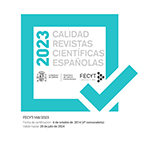LGTBIQ+ biographies in Spain, from police files to YouTube
Abstract
Biographies, embedded in the narrative conventions of a specific culture (Plummer, 1995), help to link human actions with socially understandable stories (Polkinghorne, 1988: Butler, 1991). LGTBIQ+ biographical stories in Spain have experienced a fast transformation in the last forty years. From an LGTBIQ+ biographical construction made through social control from police files during the dictatorship and post-dictatorship, to the emergence of the ‘narratives of the self’ (Ellis, 1991), 'mystories' (Ulmer y Koro-Ljungberg, 2015) or 'autoethnography' on social media. For LGTBIQ+ people, social media have provided an opportunity to generate and develop a consistent self (Beck y Beck-Gernsheim, 2003), and at the same time its political significance has been revealed (De Ridder y Van Bauwel, 2015) in a social context where LGTBIQ+ identity is fully legal but is still part of a heteronormative social context (Butler 1991; Santore 2011). Taking the accounts of Elsa Ruiz Cómica and Dulceida, we intend to understand the historical moment in which the digital LGTBIQ+ autobiographical story was emancipated in Spain. From a critical point of view (Van Zoonen, 1994) we want to focus on elements such as the authorship of the accounts; the critical moments that articulate the story; as well as the audiovisual production and aesthetics of technological mediation, which reveal the reappropriation strategies of LGTBIQ+ narratives in a historical context where LGTBIQ+ people whose police biographies are still in the archives, still live together with teenager youtubers (Gasol, 2022).
Downloads
Article download
License
In order to support the global exchange of knowledge, the journal Política y Sociedad is allowing unrestricted access to its content as from its publication in this electronic edition, and as such it is an open-access journal. The originals published in this journal are the property of the Complutense University of Madrid and any reproduction thereof in full or in part must cite the source. All content is distributed under a Creative Commons Attribution 4.0 use and distribution licence (CC BY 4.0). This circumstance must be expressly stated in these terms where necessary. You can view the summary and the complete legal text of the licence.











